Archive for the ‘Gardening at The Cloisters’ Category
Friday, May 8, 2009
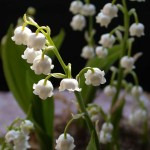
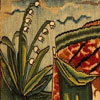
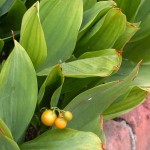
Above, from left to right: Detail of a potted lily of the valley forced for early display in Cuxa cloister; Detail of the tapestry The Queen of Sheba before King Solomon from Two Riddles of the Queen of Sheba; Lily of the valley fruiting in Bonnefont Garden in late summer.
I am the flower of the field,
And the lily of the valleys.
As the lily among thorns, so is
My love among the daughters.
???Canticle of Canticles (Song of Songs) 2:1-2
The lily and the rose are the chief adornments of the allegorical hortus conclusus, the enclosed garden of the Virgin rooted in the language of the Song of Songs in the Old Testament. Read more »
Tags: Convallaria majalis, lily of the valley, May, Solomon and Sheba, Song of Songs, Virgin
Posted in Gardening at The Cloisters, Medicinal Plants, Plants in Medieval Art | Comments (2)
Friday, April 24, 2009
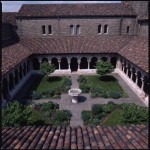
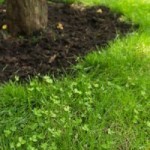
Left: A bird???s-eye view of Cuxa Cloister. Each quadrant of the garden contains a grass plot bordered with herbs and flowers. Right: Clover is planted in the lawn to provide several horticultural and ecological benefits.
In the spring of 2008, we began renovating the lawns in Cuxa Cloister by thoroughly removing the old grass with a thatch rake. We then added three inches of a mixture of topsoil and compost and raked them evenly. This was followed with a seeding of grass mixed with white clover (Trifolium repens). A thin layer of salt hay was then laid down to help retain water and protect the seed from birds. During this early stage, it is of the utmost importance to keep the soil evenly moist at all times. (Salt hay is preferable to hay as a mulch because it is free of weeds.) Once a lawn is established, however, it is best to water it as infrequently as possible. Most turf professionals recommend infrequent but deep irrigation to ensure the roots are thoroughly watered. There are many ways to conserve water in the maintenance of lawns. The most effective way is to choose the proper grass for your environment. Read more »
Tags: fescues, irrigation, lawn, nitrogen, organic, pest, rhizobia, Trifolium repens, white clover
Posted in Gardening at The Cloisters | Comments (1)
Friday, April 17, 2009
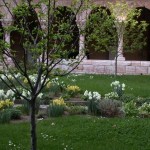

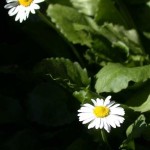
Above, from left to right: English daisies introduced into the garth garden in Cuxa Cloister some years ago; a realistic representation of the garth of a Carthusian monastery by Gerard David; the English daisy, Bellis perennis.
The sight is in no way so pleasantly refreshed as by fine and close grass kept short. It is impossible to produce this except with rich and firm soil; so it behoves the man who would prepare the site . . . first to clear it well from the roots of weeds, which can scarcely be done unless the roots are first dug out and the site levelled, and the whole well-flooded with boiling water, so that the fragments of roots and seeds remaining . . . may not by any means sprout forth. Then the whole plot is to be covered with rich turf of flourishing grass, the turves beaten down with broad wooden mallets and the plants of grass trodden into the ground . . . . For then little by little they may spring forth closely and cover the surface like a green cloth.
???Albertus Magnus, De Vegetalibus, translated by John Harvey in Medieval Gardens, 1981.
Read more »
Tags: daisy, lawn, turf
Posted in Gardening at The Cloisters, The Medieval Garden | Comments (4)
Friday, March 27, 2009
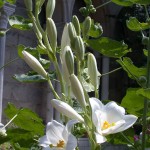
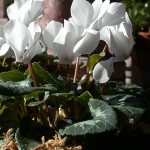
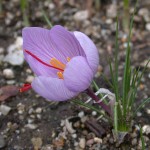
Above, from left to right: Madonna lily (Lilium candidum), cyclamen (Cyclamen persicum), and saffron crocus (Crocus sativus) in Bonnefont Herb Garden.
Many bulbous plants are grown in the gardens of The Cloisters throughout the seasons. In addition to their place in the collection as medieval species, they prolong the garden???s ornamental value, often blooming when there are no other flowers to be seen. The snowdrops (Galanthus nivalis) enliven Bonnefont Herb Garden while there is still snow on the ground. Certain bulbous plants, like the fall-blooming saffron crocus (Crocus sativus), possess a rich history that our garden lecturers are eager to discuss. However, the saffron crocus is actually not a true bulb, but actually what is known as a “corm.” Read more »
Tags: Bulbs, corm, Crocus, cyclamen, geophyte, lily, rhizome, spring bulbs, true bulb, tuber
Posted in Botany for Gardeners, Gardening at The Cloisters | Comments (1)
Friday, March 20, 2009
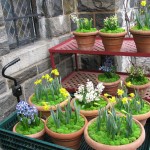
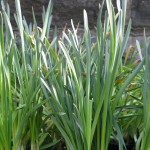
Left: Assorted bulbs; right: Spent daffodils (Narcissus pseudonarcissus ssp. obvallaris).
In the world of horticulture, the threshold between late winter and early spring is synonymous with forcing bulbs. Even if you don???t force your own, chances are you have received a pot of forced bulbs as a gift. Either way, you’re probably wondering what to do with the bulbs once the flowers have finished blooming. Many people discard them. However, with a little effort and luck, you can enjoy most forced bulbs well into the future. Read more »
Tags: Bulbs, daffodil, forcing, narcissus pseudonarcissus, spring bulbs
Posted in Botany for Gardeners, Gardening at The Cloisters | Comments (0)
Friday, March 13, 2009
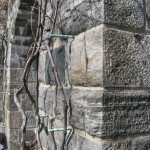
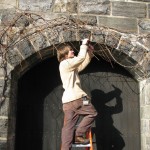
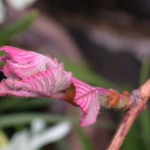
Above, from left to right: Grapevines have long been trained against the south-facing wall of the courtyard; Kevin Wiecks prunes last year???s growth back to a few dormant buds; the pink of the new foliage is transitory but beautiful.
Wine and wine grapes were of great economic and symbolic importance in the Middle Ages. Vineyards were associated both with royal and noble estates and with monasteries. Medieval wines were drunk new, and spiced wines, or piments, were also enjoyed. Wine was not only a beverage but a medicament, and the Tacuinum Sanitatis recommends grapes as a purifying and nourishing food. Read more »
Tags: grapes, grapevine, pruning, Vitis vinifera
Posted in Food and Beverage Plants, Gardening at The Cloisters, Medicinal Plants | Comments (1)
Friday, February 27, 2009
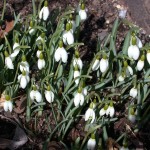
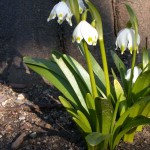
Left:??The snowdrops (Galanthus nivalis) under the quince trees in Bonnefont Cloister bloom from February to March, while snowdrops in warmer climates may flower as early as January; right: the closely related spring snowflake (Leucojum vernum) blooms from March to May.
The winter-blooming snowdrop and spring snowflake appear so closely related that the great sixteenth-century herbalist John Gerard named them the Early Blooming Bulbous Violet and the Late Blooming Bulbous Violet. Read more »
Tags: Galanthus, Leucojum, Mary plant, snowdrop, snowflake
Posted in Fragrant Plants, Gardening at The Cloisters, Plants in Medieval Art | Comments (2)
Wednesday, February 11, 2009
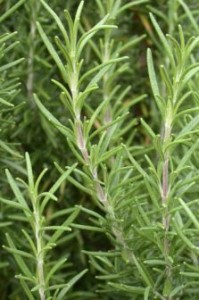
Above: A closer look at rosemary (Rosmarinus officinalis).
Most people who try to overwinter rosemary (Rosmarinus officinalis) inside are familiar with powdery mildew, Erysiphe sp. Similar to the whitefly I discussed in the earlier post, this fungus is favored by the indoor conditions that are typically provided in attempt to overwinter rosemary. Read more »
Tags: herb, Neem oil, organic, pest, powdery mildew, rosemary, Rosmarinus officinalis
Posted in Food and Beverage Plants, Gardening at The Cloisters | Comments (4)
Friday, January 30, 2009
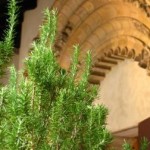
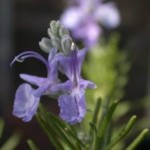
Left: Rosemary (Rosmarinus officinalis) in the arcade of Cuxa Cloister; right: a rosemary plant in flower.
Although rosemary (Rosmarinus officinalis) is one of the most popular plants at The Cloisters for its great ornamental value and colorful history, this plant does have its problems, which become especially evident when we bring it indoors during the winter months. Read more »
Tags: herb, Neem oil, powdery mildew, rosemary, Rosmarinus officinalis, whitefly
Posted in Food and Beverage Plants, Gardening at The Cloisters | Comments (10)
Friday, January 23, 2009
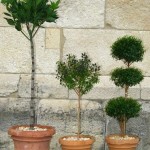
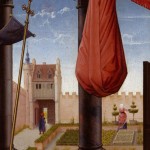
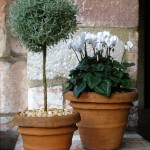
Above, from left to right: Topiaries in the plant collection at The Cloisters; detail from The Annunciation, 1465???75, Workshop of Rogier van der Weyden (possibly Hans Memling, active by 1465, died 1494) (Netherlandish, 1399/1400???1464), The Metropolitan Museum of Art, New York, Gift of J. Pierpont Morgan, 1917 (17.190.7); cotton lavender topiary in Cuxa Cloister.
Medieval topiary was relatively simple and non-representational. Woody plants were trained to standards topped by balls, or to a characteristically medieval form known as an estrade, in which the plant was grown in tiers. Although these are rarely represented before 1400, many fifteenth-century artworks show estrades and other simple, geometric forms growing both in pots and in garden beds. The more ornate representational topiary known to the Romans was revived in Renaissance Italy; the Rucellai garden in Florence, created in the second half of the fifteenth century, included animals and human figures, as well as topiary temples and urns.
The practice of artfully clipping and training woody plants into formal or fanciful shapes can be traced back to imperial Rome and the Natural History of Pliny the Elder, who attributes the relatively recent invention of nemora tonsilia or “barbered groves” to one Gaius Matius, a Roman knight and a friend of the Emperor Augustus (John Boardman, The Oxford History of the Roman World, 2001). Read more »
Tags: bay, cotton lavender, estrade, herb, Laurus nobilis, Myrtis communis, myrtle, rosemary, Rosmarinus officinalis, Santolina chamaecyparissus, topiary
Posted in Fragrant Plants, Gardening at The Cloisters | Comments (6)
























